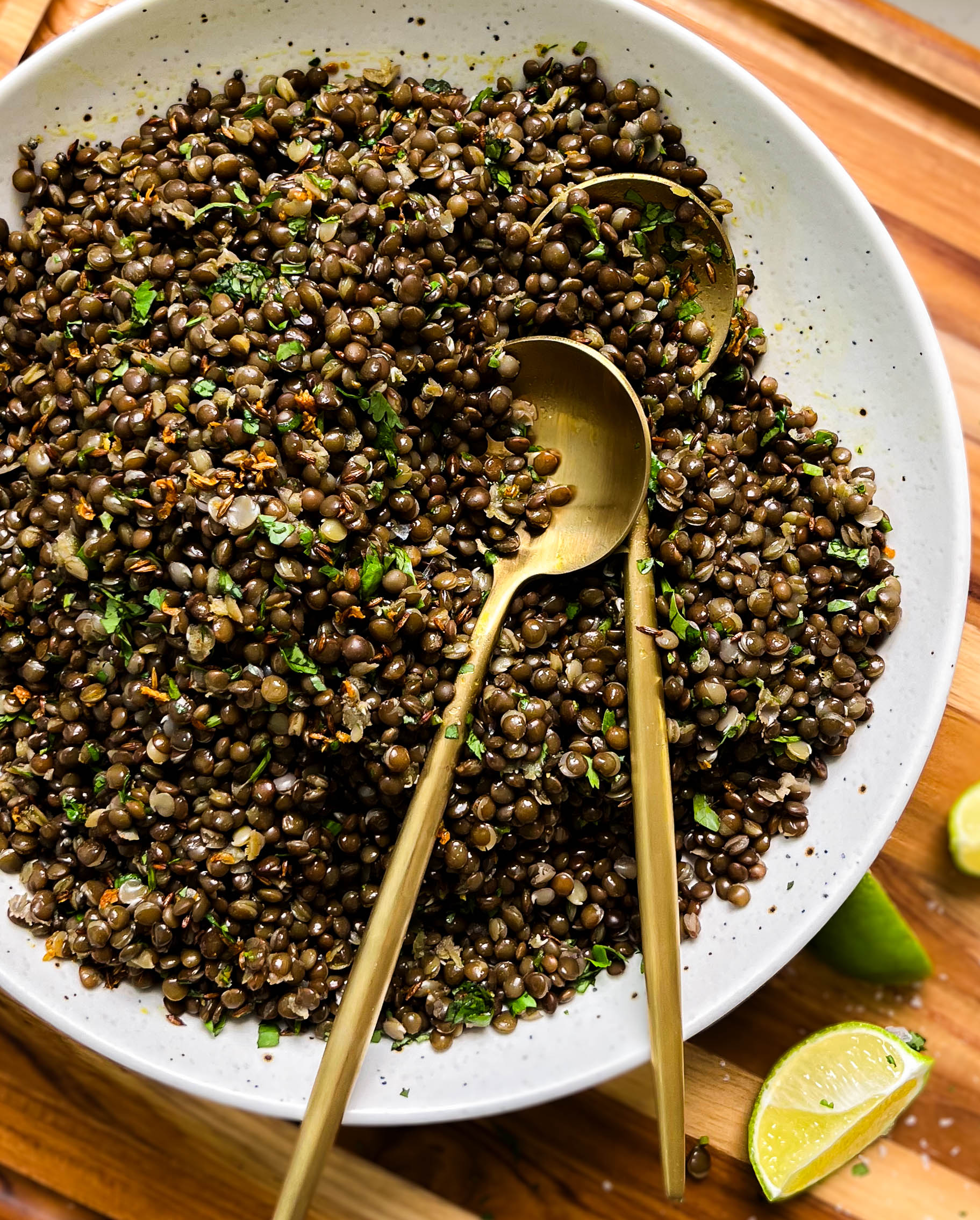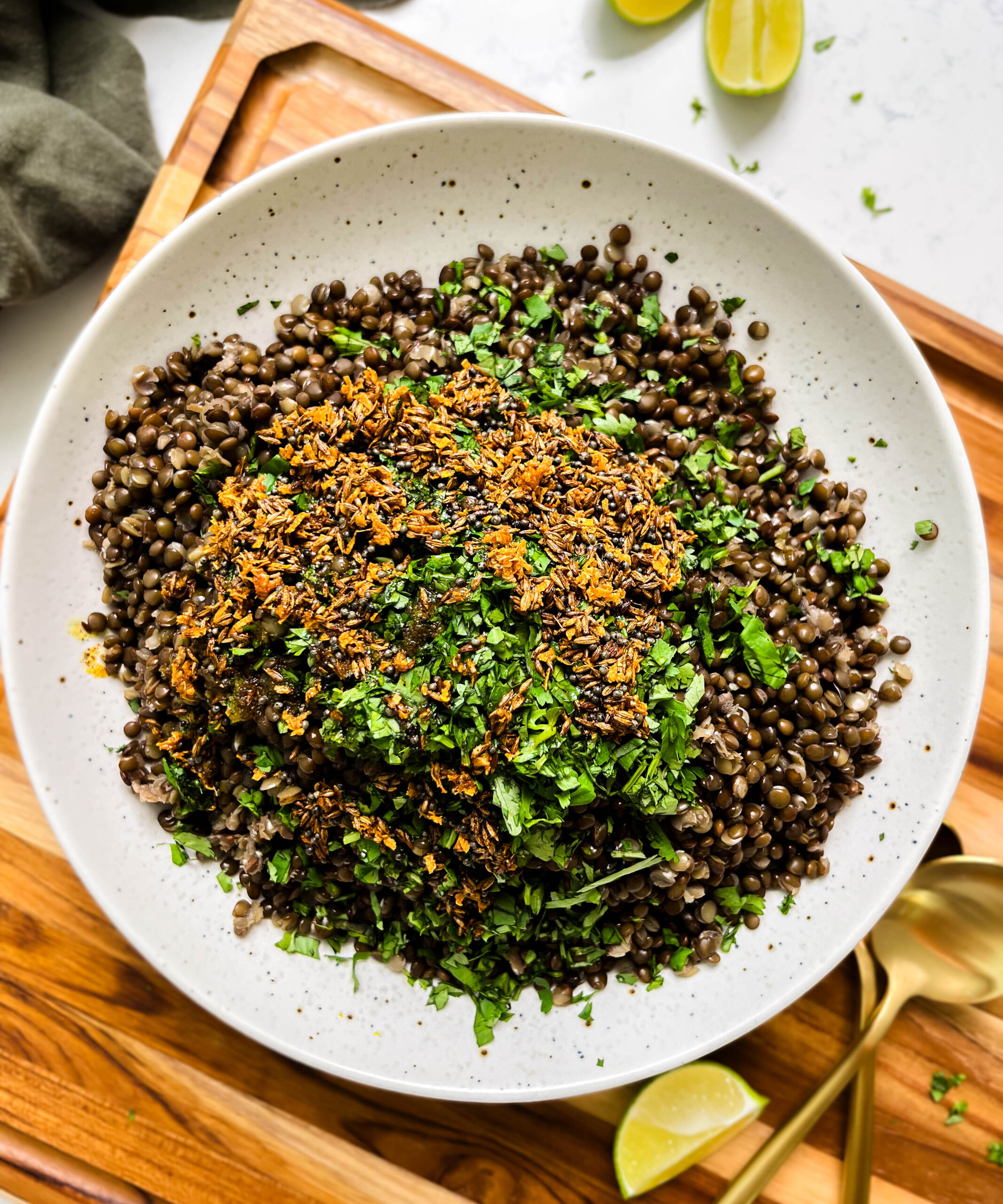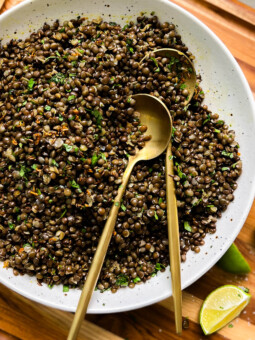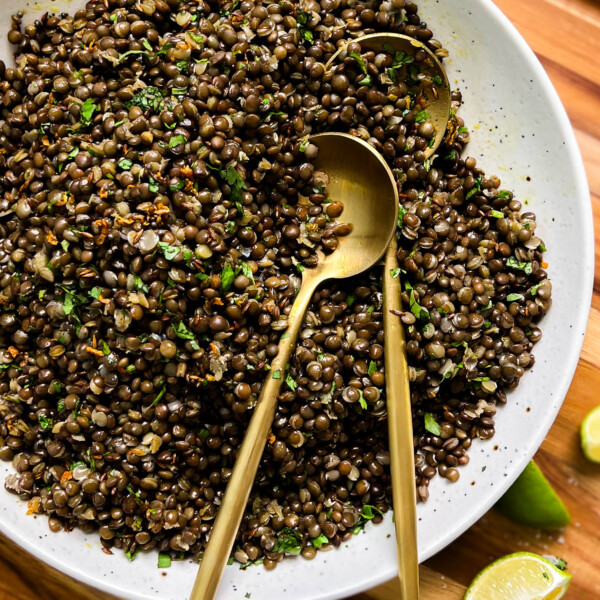If you’ve ever wanted a simple go-to recipe for lentils, look no further than this spicy black lentils recipe!
The definition of simplicity, these lentils need minimal ingredients and come together quickly.
Not to mention the fact that they’re great for meal prep and super versatile. Whether you want to pair them with rice or wrap them in pita with greens, these lentils smack lol.
Made using tadka (I’ll go in-depth into what this is in the blog post), red onion, and cilantro, you’ll be obsessed with these Indian black lentils.

Spicy Black Lentils Ingredients
Here’s everything you’ll need for this black lentil salad! As you’ll see the majority of the ingredients are spices and it’s imperative that you use whole spices for optimal flavor.
- Black lentils: Green lentils or beluga lentils also work well
- Red onion
- Cilantro
- Avocado oil
- Cumin seeds
- Mustard seeds
- Coriander seeds
- Cayenne pepper
- Garlic
- Turmeric
- Salt
The Method Behind These Spicy Black Lentils
These lentils start by cooking the lentils, duh!
Then it’s time for the star of the dish, the tadka, aka tons of aromatic spices bloomed in avocado oil. This gets poured over top of the lentils, along with cilantro, red onion, and salt. That’s it!
But let’s get into what‘tadka’ is, the backstory, the science, and how to use this method properly!

Backstory On Tadka
Ok, so what is tadka, also referred to as chaunk (chhonk)?
Tadka is not an actual dish or recipe but rather a method of blooming spices in oil or ghee to create an aromatic flavor-packed sauce. Usually poured over dal to add richness and complexity!
Depending on the types of spices, herbs, and fat used, the tadka can change dramatically in terms of flavor, texture, and color.
One good way to think of tadka is as a layer of flavor. Just like many soup recipes, stocks, etc. start with browning veggies to build more flavor. Tadka does the same but on a more intense level in my opinion.
Oh and as a note, tadka refers to both the method and the spiced oil.
An Additional Note
And lastly, I wanted to point out that in many Asian countries, spices are bloomed in hot oil. So of course there are numerous names for this technique.
This method I’m sharing is rooted in Indian culture and is called many different names depending on the region/language. Some common names for this method are tadka, chaunk, phanna, baghar, and other names for this technique and powerful flavor agent!

The Science Behind Tadka
There are three main players in tadka: heat, fat, and spices. So here’s what you need to know about each of these three components.
Heat
Using heat produces reactions; caramelization and the maillard reactions. These reactions happen to all foods. And for these spices in tadka, their essential oils inside are transformed chemically through heat.
One additional note for using heat for tadka is that most spices (and herbs) are dried. Drying spices ‘freezes’ the flavor molecules in place and increases their shelf life.
But also conversely, depletes their flavor and aroma. Blooming spices in oil at high heat can ‘unfreeze’ and help draw out the spices’ flavor and aroma.
Fat
As I said above, most spices are dried and need to have their flavor/aroma extracted. And since most flavor molecules in spices are fat-soluble, they can easily be extracted using fat.
I recommend choosing your fat wisely! In most cases, I like to use neutral fats like avocado or olive oil.
Ghee, coconut oil, and sesame oil are more flavorful fats that will lend their flavor to the tadka — just something to keep in mind!
Spices
Ok, the last component! Spices!
Whole spices like cumin seeds, coriander, and mustard seeds are the usual. But lightly cracking them can help with infusing the oil with even more flavor.
That said, if you use ground spices, they will cook faster and release flavor more quickly than whole spices.
Additionally, fresh ingredients and herbs, like garlic, onion, and ginger can be added to tadka for extra flavor and texture.
Typical spices and aromatics you’ll see in tadka are coriander, cumin, fennel, mustard seeds, cardamom pods, turmeric, onions, shallots, ginger, chilies, bay leaves, curry leaves and garlic. To just mention a few lol.
Ok, now that you know everything you need to know about tadka, let’s get into how to make these spicy black lentils!

How To Make These Spicy Black Lentils
Start With The Lentils
- Start by adding the lentils in a large pot and covering them with water. Rinse the lentils until the water turns black, then drain and rinse another two times. Three times total. This will help get rid of any residual dirt, sediment, etc.
- Place the pot on the stove and bring the lentils to a boil on high heat. Then turn the heat down to medium and let the lentils cook, without a lid, for 20-25 minutes. Once 25 minutes is up, the lentils should be done — they should be soft to the touch with just a bit of bite.
- While the lentils cook, chop the red onion into small pieces and finely mince the cilantro. Add these both into a mixing bowl.
- When the lentils are done, drain and rinse them in a colander and add them into the mixing bowl with the onion and cilantro. Set aside.
Make The Tadka
- Onto making the tadka. Using the same pot you used to cook the lentils (save yourself some dishes, just make sure it’s completely dry) add the avocado oil. Place the pot on the stove and turn on medium heat. Once the oil is shimmering and hot add in the cumin seeds, coriander seeds, mustard seeds, cayenne pepper, turmeric, and fresh garlic. If you want you can also add a bay leaf. One good way to test the oil is by dropping in one or two whole spice seeds (based on what you’re using) such as cumin, coriander, or mustard. The spices will sizzle immediately if the oil is sufficiently hot.
- Let the spices cook for one minute MAX! Any longer and the spices will burn and make the tadka bitter. The whole spices will turn a toffee color and stop sizzling as much, signaling that they’ve released their flavor. Additionally, use your nose — your kitchen will smell fragrant with the spices!
Combine Everything
- Once the tadka is done, pour it over the mixing bowl. Squeeze over the lemon juice and sprinkle with salt. Toss to combine and adjust seasoning to taste.
- Enjoy these lentils on their own, with rice, in a tortilla or however you like.

Even More Spicy Vegan Recipes
Sharing Is Caring!
If you make this recipe, please leave a review and rating below. And don’t forget to snap a picture and tag me on either Instagram or TikTok (if you’re not already following me, make sure to for new recipes and wellness tips)!
Print
Spicy Black Lentils
- Prep Time: 20
- Cook Time: 35
- Total Time: 55 minutes
- Yield: 4 1x
- Category: Dinner
- Cuisine: Indian
Description
The definition of simplicity, these lentils need minimal ingredients and come together so quickly. Not to mention the fact that they’re great for meal prep and super versatile. Whether you want to pair them rice or wrap them in a torialls with greens, these lentils smack!
Ingredients
- 1 cup black lentils (soaked overnight if you can)
- ½ medium red onion (optional)
- 1 head fresh cilantro, leaves only
- 4 tbsp avocado oil
- 1 dried bay leaf (optional)
- 2 tsp cumins seeds
- 2 tsp mustard seeds
- 2 tsp coriander seeds
- 2 fresh garlic cloves, finely minced or grated
- 1 tsp cayenne pepper
- ½ tsp ground turmeric
- Kosher salt to taste, about 1 tsp
Instructions
- Start by adding the lentils in a large pot and covering with water. Rinse the lentils until the water turns black, then drain and rinse another two times. Three times total. This will help get rid of any residual dirt, sediment, etc. If you soaked your lentils overnight, this is especially important.
- Place the pot on the stove and bring the lentils to a boil on high heat. Then turn the heat down to medium and let the lentils cook, without a lid, for 20-25 minutes. Once 20 minutes is up, the lentils should be done; they should be soft to the touch with just a bit of bite.
- While the lentils cook, chop the red onion into small pieces and finely mince the cilantro. Add these both into a mixing bowl.
- When the lentils are done, drain and rinse them in a colander and add them into the mixing bowl with the onion and cilantro. Set aside.
- Onto making the tadka. Using the same pot you used to cook the lentils (save yourself some dishes, just make sure it’s completely dry) add the avocado oil. Place the pot on the stove and turn on medium heat.
- Once the oil is shimmering and hot add in the cumin seeds, coriander seeds, mustard seeds, cayenne pepper, turmeric and fresh garlic. If you want you can also add a bay leaf. One good way to test the oil is by dropping in one or two whole spice seeds (based on what you’re using) such as cumin, coriander, or mustard. The spices will sizzle immediately if the oil is sufficiently hot.
- Let the spices cook for one minute MAX! Any longer and the spices will burn and make the tadka bitter. The whole spices will turn a toffee color and stop sizzling as much, signaling that they’ve released their flavor. Additionally, use your nose, your kitchen will smell fragrant with the spices!
- Once the tadka is done, pour over the mixing bowl, and sprinkle with salt. Toss to combine and adjust seasoning to taste.
- Enjoy these lentils on their own, with rice or with pita bread.
Notes
I recommend soaking the lentils overnight so they can sprout. This makes the nutrients more bioavailable. Plus, soaking the lentils makes it easier for your gut to digest.
Store these lentils in an airtight glass container in the fridge for up 5 days.


Pingback: Foods I Eat Every Day (to optimize health) | Munching With Mariyah
Pingback: Shirazi Salad | MWM
Pingback: Vegan Pasta Salad | MWM
Pingback: Vegan Dal Makhani | MWM
Love it love it love it. Delicious thankyou so much. Your recipes are an inspiration.
Made my day to read this, thank you so much Maureen!!
Hi! There is a discrepancy in the blog section verses the recipe section. The Blog states 15 minutes cooking, but the recipe section states 20-25 minutes to cook. Which is correct? Also, how much water do I add to the pot for boiling?
I look forward to making this soon!
Thanks so much for flagging that, just updated the blog text to reflect the 20 minute cook time. I fill up the water about 2 inches above the lentils so they have enough room to boil – think of it like cooking pasta. Super excited for you to make this dish, it’s one of my favorites!!
Can’t get enough of this recipe! Will be making this often. Thank you for this recipe!